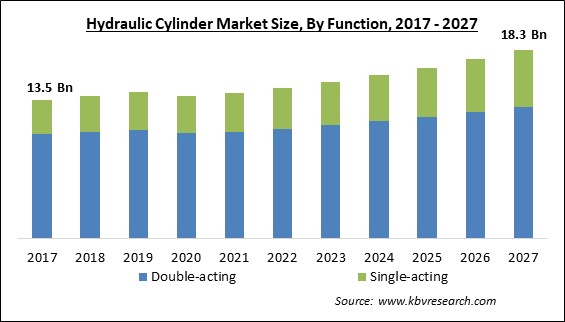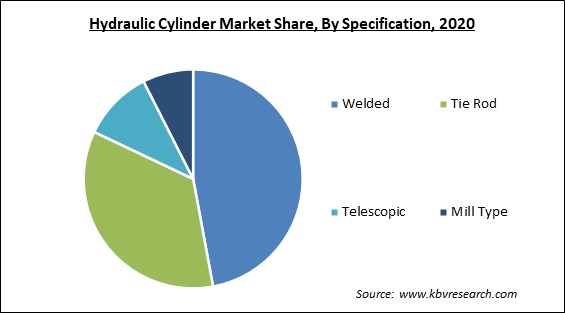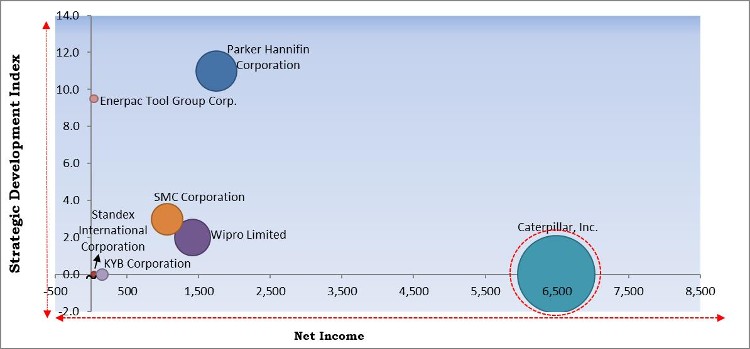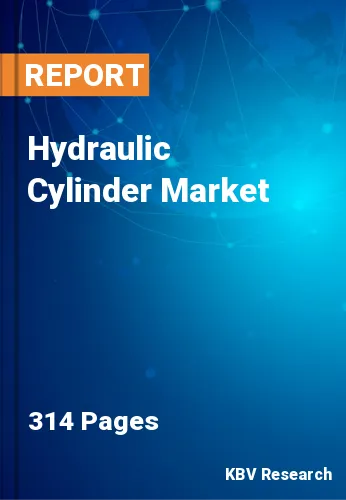The Global Hydraulic Cylinder Market size is expected to reach $18.3 billion by 2027, rising at a market growth of 4.4% CAGR during the forecast period.
A hydraulic cylinder is a mechanical device that is used to apply a unidirectional force via a single-direction stroke. It's a device that converts mechanical force into linear motion. The tube of a hydraulic cylinder has a rod protruding out on one side. To avoid friction, the piston separates the internal rod side from the internal cap side of the cylinder. For smooth operation, fluid is pumped into either side of the cylinder to expand or retract the piston rod.
A hydraulic cylinder is a component of the hydraulic system of a machine. Put simply, a hydraulic cylinder is a hydraulic actuator that converts hydraulic energy into a mechanical movement to provide linear movement. The hydraulic cylinder is similar to a muscle in that it causes movement using the machine's hydraulic system - so it is similar to a muscle.
The medium of the hydraulic transmission is oil. The basic principle of hydraulics is that when a power machine rotates the pump, a volume flow is created. The hydraulic system's pressure is determined by the load created by the cylinder or valve, which then resists the flow of the liquid created by the hydraulic pump. Pascal's law states that pressure spreads evenly in all directions in the system and has an equal effect on all hydraulic system closed spaces' surfaces and this effect is put at work in this mechanism.
A simple ram-type cylinder is made up of a cylindrical tube, and a steel rod that is inserted and sealed inside the tube. A pressurized fluid is pumped into the cylinder, where the circular bottom of the tube is subjected to pressures of up to 3000 psi or more. As long as the mass on the rod is less than the force generated against the rod by the fluid, the pressured fluid will push the rod out of the cylinder. It should be highlighted that motion is created by force, not flow; the generation of movement by flow is a common fallacy that will be addressed another day.

The outbreak of the COVID-19 pandemic has negatively impacted various business sectors across the world. Various impositions like lockdown, social distancing and ban on imports & exports have impacted the production and distribution of various goods and services, which were considered as non-essential by the governments. Many enterprises in the hydraulic cylinders industry were obliged to temporarily suspend operations due to the COVID-19 pandemic, in order to comply with new government rules aimed at preventing the disease's spread. This pause in activities has a direct influence on the market's revenue flow.
Construction projects are progressively growing in size and complexity. Despite the fact that the COVID-19 pandemic had an impact on the construction industry, there has been a strong recovery in the industry following the pandemic, mainly owing to growing infrastructure spending in APAC and recovering European infrastructure investments. Infrastructure investments are accelerating in emerging economies such as China, India, Indonesia, and other countries due to rising urbanization. Numerous new infrastructure development plans and projects are in the works, mostly in developing countries like India and China, which would eventually drive construction equipment demands.
Hundreds of feet of cargo containers of various sizes and weights are routinely piled in dockyards. Containers with typical sizes of 20, 40, 45, 48, and 53 feet and weights of 30 to 42 tons can be found all over the world. Lifting machinery is used to transport these large containers. Shipping is the most essential means of international commerce facilitation on the planet. Ships deliver the bulk of goods, including electronics, autos, textiles, raw metals, and oil and gas. The rise of the shipping sector is fueled by favorable institutional and technological factors such as the adoption of industrial IoT and government backing, which supports the demand for lifting equipment at ports.
In the production of a high-quality hydraulic cylinder, metal forging and accurate engineering are required. Hydraulic cylinders are made up of various parts that must be assembled, including pistons, cylinder barrels, piston rods, cylinder bases, cylinder heads, and cylinder seals. Small and medium-sized businesses (SMEs) face cost constraints when it comes to entering the hydraulic cylinder industry. Hydraulic cylinders have ongoing maintenance expenditures in addition to the initial product price.

Based on Function, the market is segmented into Double-acting, and Single-acting. The double-acting segment acquired the largest revenue share in the hydraulic cylinder market in 2020. These cylinders are employed in aircraft, automotive, agriculture, and a variety of other industries because of their retraction properties. Mobile applications like lifting equipment, earth moving equipment, forklifts, and heavy trucks have a larger demand for these cylinders. Double-acting hydraulic cylinders are used to open and close drawers in presses and chippers, as well as all forms of lifting and lowering machines like excavators and cranes.
Based on Specification, the market is segmented into Welded, Tie Rod, Telescopic, and Mill Type. The tie rod segment observed a substantial share in the hydraulic cylinder market in 2020. Increasing the use of agricultural equipment for farming in order to increase production capacity in order to keep up with the rising population rate will boost industrial dynamics. According to the International Trade Administration, the Russian agricultural sector, with 220 million hectares of land, has the potential to strengthen the economy.
Based on Bore Size, the market is segmented into 50-150 MM, <50 MM, and >150 MM. The greater than 151 mm segment procured a significant revenue share in the hydraulic cylinder market in 2020. This is due to an increase in the popularity of exclusive quality and warranty schemes in manufacturing plants for the greater than 150 mm segment.
Based on Application, the market is segmented into Mobile, and Industrial. The mobile segment acquired the largest revenue share in the hydraulic cylinder market in 2020. Hydraulic cylinders are required for the operation of mobile equipment such as excavators, loaders, and cranes. Hydraulic cylinders are used in earthmoving, material handling, mining, and the military in the mobile equipment business. The demand for hydraulic cylinders in mobile applications will grow as industrialization and building activities expand.
Based on Industry, the market is segmented into Construction, Aerospace, Material Handling, Mining, Agriculture, Automotive, Marine, Oil & Gas, AND Others. The agriculture segment observed a promising revenue share in the hydraulic cylinder market in 2020. The agriculture industry is expanding as more machines are used to do difficult jobs, such as planting vegetables and plowing fields. Hydraulic cylinders are used in practically all agricultural equipment for lifting and movement control, from pecan tree shakers to sugar cane harvesters, automated bale trucks to sprayer booms. The agriculture business is under pressure to supply global food demand due to rising population and decreasing environmental conditions. This has resulted in a rise in investments in precision agriculture machines, which is projected to stimulate demand for hydraulic cylinders.
| Report Attribute | Details |
|---|---|
| Market size value in 2020 | USD 13.9 Billion |
| Market size forecast in 2027 | USD 18.3 Billion |
| Base Year | 2020 |
| Historical Period | 2017 to 2019 |
| Forecast Period | 2021 to 2027 |
| Revenue Growth Rate | CAGR of 4.4% from 2021 to 2027 |
| Number of Pages | 314 |
| Number of Tables | 584 |
| Report coverage | Market Trends, Revenue Estimation and Forecast, Segmentation Analysis, Regional and Country Breakdown, Competitive Landscape, Companies Strategic Developments, Company Profiling |
| Segments covered | Function, Specification, Bore Size, Application, Industry, Region |
| Country scope | US, Canada, Mexico, Germany, UK, France, Russia, Spain, Italy, China, Japan, India, South Korea, Singapore, Malaysia, Brazil, Argentina, UAE, Saudi Arabia, South Africa, Nigeria |
| Growth Drivers |
|
| Restraints |
|
Based on Regions, the market is segmented into North America, Europe, Asia Pacific, and Latin America, Middle East & Africa. Asia-Pacific region acquired the largest revenue share in the hydraulic cylinders market in 2020. The market is developing due to the rising demand for agricultural, construction, and mining equipment in this region. Agriculture and construction sectors in the region are growing in response to rising food demand from the region's growing population and increasing industrialization in emerging countries. In APAC, hydraulic cylinders are mostly sold in Japan and Australia. Major car manufacturers and suppliers in Japan are facing growing labor costs and longer lead times as a result of manual operations. Companies are implementing automated and semi-automated material management systems to tackle these issues. Minerals are plentiful in Australia, and their extraction is boosting the demand for mining equipment that comes equipped with hydraulic cylinders.
Free Valuable Insights: Global Hydraulic Cylinder Market size to reach USD 18.3 Billion by 2027

The major strategies followed by the market participants are Product Launches. Based on the Analysis presented in the Cardinal matrix; Caterpillar, Inc. is the major forerunner in the Hydraulic Cylinder Market. Companies such as Parker Hannifin Corporation, SMC Corporation, Enerpac Tool Group Corp. are some of the key innovators in the Market.
The market research report covers the analysis of key stake holders of the market. Key companies profiled in the report include Wipro Limited, Caterpillar, Inc., Parker Hannifin Corporation, Standex International Corporation, Kawasaki Heavy Industries, Ltd., SMC Corporation, KYB Corporation, Enerpac Tool Group Corp., Ligon Industries, LLC, and HYDAC International GmbH.
By Function
By Specification
By Bore Size
By Application
By Industry
By Geography
The global hydraulic cylinder market size is expected to reach $18.3 billion by 2027.
Rising Demand For Lifting Machinery From The Shipping Industry are driving the market in coming years, however, high costs of manufacturing and maintenance of hydraulic cylinders limited the growth of the market.
Wipro Limited, Caterpillar, Inc., Parker Hannifin Corporation, Standex International Corporation, Kawasaki Heavy Industries, Ltd., SMC Corporation, KYB Corporation, Enerpac Tool Group Corp., Ligon Industries, LLC, and HYDAC International GmbH.
The 50–150 MM segment acquired the maximum revenue share in the Global Hydraulic Cylinder Market by Bore Size in 2020; thereby, achieving a market value of $10.4 billion by 2027.
The Construction market dominated the Global Hydraulic Cylinder Market by Industry in 2020, and would continue to be a dominant market till 2027.
Asia Pacific is the fastest growing region in the Global Hydraulic Cylinder Market by Region in 2020, and would continue to be a dominant market till 2027; thereby, achieving a market value of $7.2 billion by 2027.
Our team of dedicated experts can provide you with attractive expansion opportunities for your business.

